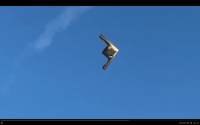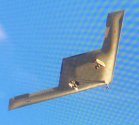Regarding the upgrades on the Flight IIA Arleigh Burke:
If it shows anything then it would the fact that those destroyers are still marvelous platforms after almost 40 years.
No they're not. For 2020s and beyond they're horrible
platforms. Don't conflate the systems installed on a ship with the ship itself.
Burke-class demonstrated obsolescence of its architecture in
1997, when first Flight IIA DDG-79 was laid down, merely a decade after DDG-51 but it wasn't obvious then.
- The difference between Flight I (DDG-51 to 71) and Flight II (DDG-71 to 78) is in combat sub-systems and 100t of displacement.
- The difference between Flight II and IIA is in hull structure and role and 1100t of displacement.
While Flight I/II are AAW destroyers Flight IIA are both AAW and ASW destroyers because they were introduced as replacement for Spruance-class.
All 31 Spruances were retired according to condition between 1998 (7 ships, oldest at 20 years) and 2005 (3 ships, oldest at 30 years). Because Spruance was the primary ASW ship for CSGs replacement was necessary immediately and the existing Burke design was adapted. And it was done poorly because even though Spruance, Ticonderoga and Arleigh Burke are the same evolutionary family of hulls with the same propulsion (4x LM2500) Arleigh Burke was designed as specialised AAW ship to augment Ticonderoga cruisers. When Spruance was retired CSG lost a dual hangar ASW warship which was essential for existing CSG tactics. So instead the hull was lenghtened by 1,5m and two hangars were bolted to both sides of stern VLS which was possible because beam is 20m.
Except Burke wasn't designed as an ASW ship so the reasonable AAW layout of Flight I and II became a minor obstacle for a multi-role warship. It was also an AAW hull so it wasn't up to latest parameters for ASW hulls being developed for the next generation of ships but since it was effectively the same as Spruance it passed the arbitrary threshold in Pentagon/Congress where it was assumed that there won't be peer opponents.
And 25 years later exactly the same design is being built for dual AAW/ASW role because USN has nothing to replace it with. First Constellation frigate based on Italian FREMM (said next generation of ASW ships, but now already a 15-year-old design) is entering service in 2026.
This is Flight I/II - a reasonable 1980s design for an AEGIS + 90 VLS AAW destroyer which was supposed to be cheaper than Ticonderoga an AEGIS + 122 VLS cruiser. Try to imagine wiring and power generators inside the ship.
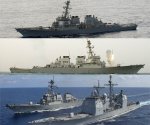
Take a look here: red lines indicate geometry of the forecastle and yellow lines of mid-ship structure.
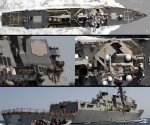
The original open bridge above the EW system extends by approx. 80% of the length of the vertical side of the radar antenna cover. On the modernised ship it extends even further.
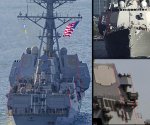
Because the requirements for EW systems increase with each generation and area coverage is essential they keep growing in size and power. In modern designs which are more modular and utilise distributed sensor architecture there is space for power relays all over the ship. On Burke there aren't because it was optimised as a cheaper Ticonderoga. So no matter how large the EW system it always will be placed where all the internal supporting structure - power cables, technical access etc - was already in place.
On images it looks ugly but it is mostly empty space most likely with direct access from inside of the ship. DDG-91 was commissioned in 2004 so it has until 2039 to serve and 2023 is exactly the time for its mid-life upgrade. This means that it likely also has upgraded main radar - AN/SPY-6(v)4 with 24 RMAs (compared to baseline 37 RMA for AN/SPY-6(V)1 of Flight III).
Ironically in this case Burke being "modern" with AEGIS-optimised ship architecture proved to be a bottleneck compared to older architectures with twin radars. Compare with European designs of the 2000s:
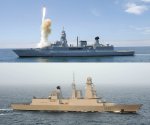
Or with the recent Japanese non-AEGIS destroyers. All the navies which relied on "inferior" sensor architecture with two radars avoided costly errors of optimisation for AN/SPY-1.
So the ugly EW upgrade is not that bad of an idea. The notion that Flight IIA/III can be a capable ASW or multirole ship in 2030s is a bad idea but that was over 25 years ago.
Again people are laughing at practical solutions and remain completely oblivious to genuine flaws. But it doesn't matter as long as keyboard warriors can score a point. It's morbidly facinating because all the people fighting each other are really on the same side. The side of stupidity.
Anyway, since we're talking about fateful choices coming back to bite after a decade or so...
The report on the performance between the A-10 and the F-35 in COIN/CAS...
According to those articles USAF is really cutting off the
institutional branch that US Army hangs on to. So far I haven't seen anything that could fill the gap like unmanned systems with similar capability.
Institutional knowledge of working with infantry is fundamental to success in CAS. It's unique due to how un-technological a mission it is. It's a more challenging version of coordinating infantry and tanks and anyone who pays attention to how various armies resolve this knows that regular and extensive practice is the only way to develop the capability. And USAF is determined to lose it.
CAS is more about psychological effect than anything. This is why the gun is useful - it is powerful enough to force enemy to take cover. A-10 has 1200 rounds compared to 250 for Su-25 so while Su-25 is the better workhorse plane the low ammo is a weakness that prevents it from being more useful than it is.
Currently USAF has
281 A-10C (per 2023 Almanac) of which
142 active. The intended replacement for FAC(A) is
75 OA-1K by 2029 which is AirTractor derivative.
AT-802 has 400/330 km/h max/cruise speed and 8 underwing pylons for weapons. A-10C has 550km/h cruise speed and over 7t of payload. OA-1K will perhaps carry half or third of that. A-10C has ceiling of over 10km while AT-802 has
4km max and with payload operates at 1,5-2km.
It may be enough for SOCOM missions but not for any
regular conflict against an adversary with basic AA like 12,7mm or 23mm.
And if you compare visibility from A-10 to that of AT-802 then the wing is directly obscuring the view.
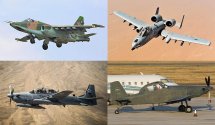
The OA-1K has two EO heads looking forward and back under each wing. In theory it may be enough, in practice nobody knows because there is no practice with US Army regulars and no "fight as you train, train as you fight".
This really reminds me of the Kiowa Warrior which was to be replaced by "superior" Apache and drones, and now US Army complains about capabilities and cost, but can't do anything about it because they have no money for proper recon helo.
It really puts the whole "keep A-10 flying" campaign in perspective. Apparently it's not as stupid as F-35 shills and fanboys make it seem.






